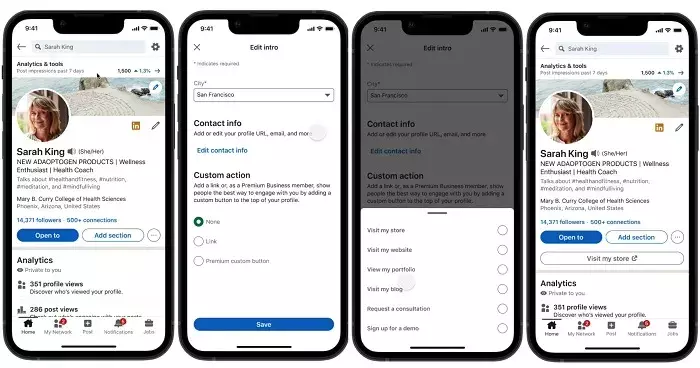LinkedIn has recently stirred discussions within its user community by announcing the removal of the ability to add custom links to individual profiles, a feature initially extended to Premium subscribers. For those who have creatively utilized this feature, the custom call-to-action (CTA) buttons were a powerful tool, enabling users to direct profile visitors to external sites such as personal websites and online stores. The allure of crafting tailored profile experiences met a jarring halt with LinkedIn’s decisive move to eliminate this option entirely. The company stated, “At LinkedIn, we are constantly evaluating our features and thinking about how we can best add value for our members and customers,” which suggests that the decision was rooted in a desire to streamline the platform and enhance users’ experiences overall.
This shift raises interesting questions about LinkedIn’s strategic priorities. By prioritizing the functionality that ostensibly delivers the highest engagement and value, they may be sidestepping the nuanced interactions that personalized links can foster. Users often rely on these custom CTAs to brand themselves, create professional opportunities, and drive traffic to their initiatives. While LinkedIn insists on enhancing its platform’s value, withdrawing features that empower individual users may not resonate positively with many of its members.
Understanding the Impacts of Premium Features on User Engagement
The removal of custom links highlights the distinct disparity between personal users and corporate accounts on LinkedIn. Currently, there are around 175 million premium subscribers, and this figure has risen significantly due to an increase in the usage of Premium Company Pages, which allow brands to stand out in the digital space. Interestingly, these pages still retain the functionality of custom CTA buttons prominently displayed for maximum visibility. The corporate accounts are apparently anticipated to yield substantially higher engagement, with reports indicating that they see over ten times more clicks on CTA buttons than standard profiles.
This data points to a critical realization for LinkedIn: businesses are driving interactions in ways that individual users may not. By focusing its resources on corporate functionalities, LinkedIn not only reaffirms its roots as a professional networking site tailored for businesses, but it may inadvertently alienate individual members who increasingly seek robust tools for personal branding. It’s pivotal to ask whether LinkedIn can maintain balance; after all, the platform’s strength stems from a diverse ecosystem of personal and professional user interactions.
Evaluating the User Experience and Future Implications
The decision to retire the custom link feature may also reflect LinkedIn’s understanding of usage trends among its members. Despite having a considerable number of premium subscribers, the platform may have determined that the custom links weren’t leading to significant engagement or traffic. In a digital era where users favor streamlined, efficient interactions, LinkedIn is cognizant of the need to minimize clutter on its platform. However, while the removal of such features may simplify the user interface, it runs the risk of diminishing the creative and individualistic aspects that many users value.
Moreover, the decision could be seen as part of an overarching strategy to regulate the sorts of links shared on LinkedIn. Concerns regarding inappropriate or misleading links could lead to potential issues surrounding trust and credibility on the platform. By taking away the ability to add new links, LinkedIn may be attempting to safeguard its reputation, especially as it competes with lesser-regulated platforms where inappropriate content has often blurred the lines of professionalism.
Yet, one must ponder whether this is the right approach for a community that thrives on connectivity and fostering relationships. LinkedIn’s trajectory leans more toward a concentration on business profiles at the expense of individual enrichment, which could lead to a stifling of creativity. Striking an equilibrium between company interests and individual empowerment may prove vital for retaining a versatile user base in a competitive landscape.
The ongoing transformation within LinkedIn is emblematic of its attempt to evolve while addressing the complex dynamics of its users. While the corporate push may seem economically rational for LinkedIn, the nuances of user engagement could easily be compromised, raising concerns about the platform’s future positioning as a space for personal growth as much as professional networking.

